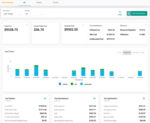
A new year is always a good time to check your expenses. One expense that keeps on climbing constantly in many organizations is related to the cloud expenses, expected to expand up to $1 trillion by 2024, according to IDC. While this can be a good thing, indicating the business is scaling and cloud resources are in high demand, there is often a lot of waste coming from inefficient cloud usage, unnecessary SaaS tooling, endless logs and more.
Let’s take a look at 10 quick ways to reduce cloud costs for 2022:
1. Remember to scale down
One of the powerful premises of the cloud is the ability to scale. However, after new cloud resources are provisioned – say after a major traffic spike – it’s your responsibility to scale back down once traffic returns to a steady state. If you don’t, those resources are still eating up budget even if they are no longer needed. There are both open-source and SaaS tools that will alert you when thresholds are crossed so that there are no major end-of-quarter surprises.
2. Take advantage of spot instances
Cloud providers maintain large amounts of excess capacity they have available to sell, known as spot instances. For example, an AWS EC2 Spot Instance is an unused EC2 instance that is available for less than the on-demand price – sometimes up to 90% cheaper, which can significantly reduce your EC2 costs.
3. Join a resource swapping service
Resource swapping is a service designed to make use of your own idle servers. Many people don’t even know these services exist! Check the security aspects first and see if you are comfortable with them, but it could be a good way to claw back some money for resources you aren’t using.
4. Perform cross-organization checks
Why would you pay for multiple Netflix subscriptions within your family? Now duplicate that logic by 10X or 100X and you have an organization. Many teams are moving fast and adopting tooling, often double-paying unnecessarily for something another team has already paid for. Look at all of the cloud tooling and services being used and cut the duplicates (or the ones not being used at all) – that money is better spent elsewhere!
5. Embrace the digital economy
New startups often try to take market share by underpricing their solutions. Keep your eyes out and be willing to give these tools a chance. Some of them won’t meet your standards, but many will satisfy your requirements and perhaps even totally replace an expensive tool you already have.
6. Consolidate tooling where possible
Every company struggles with the balance of purchasing point solutions versus bigger enterprise solutions that can check multiple boxes. Here at Rookout, we are a dev-forward organization and believe in using the best tool for the job. That said, as DevOps and DevSecOps platforms grow – either by adding new features or acquiring new companies – you may find that the new capability from your service provider is actually useful! It will likely be cheaper to turn on additional functionality within an existing tool than adopting a new tool altogether.
7. Embrace open source
There are so many great tools that are completely free to use, thanks to the wide adoption of open source. You may find that with minimal development effort on your end, you can get the value you need from an open-source project without paying for an entire platform. Look also at the many SaaS vendors in the Dev and DevOps space promoting their free tier, which may address your exact immediate need.
8. Choose the right size
Think of a car lease. You want to commit to mileage that you know you will stay under, because if you go over the prices increase drastically. This is also true with the cloud. Taking too small of a cloud package in order to save some money upfront will eventually cost more, as you will end up crossing the threshold and paying extended fees. Size right and save paying the extra charge.
9. Prioritize your data
Data is the new oil they say – so now it’s common to try and save all of the data, all of the time. But this costs a lot of money…which is why having a smart policy for storing your data is a must. APM tools will often allow you to send logs to a low-level aggregation pool, which is a good option for non-critical applications.
10. Embrace Dynamic Observability and Logging
In the past, fetching a piece of data or adding new logs required writing code and redeploying the application. Today, thanks to advances in methodology like bytecode manipulation, it’s possible to retroactively add log lines and fetch data on demand with the click of a button. Keep an eye out for these dynamic observability and logging tools, which will be on the rise in 2022.







